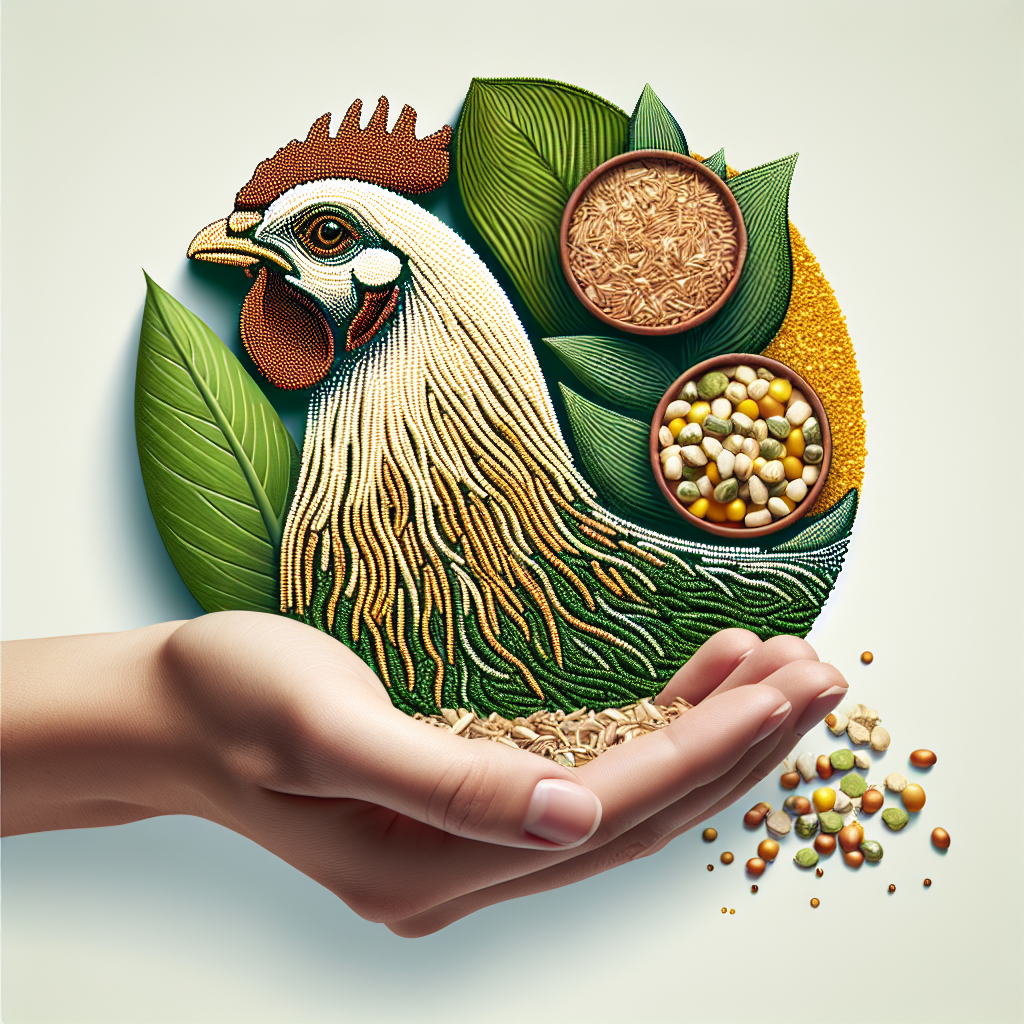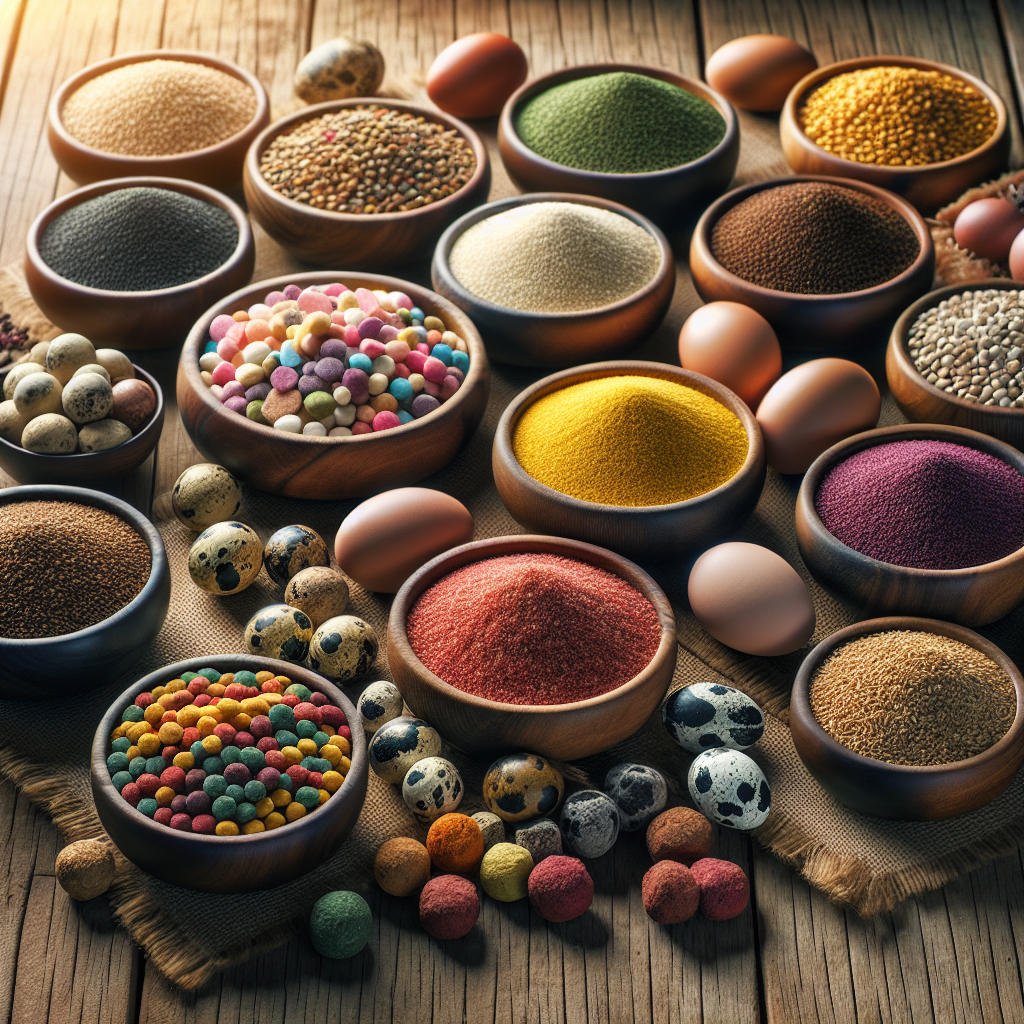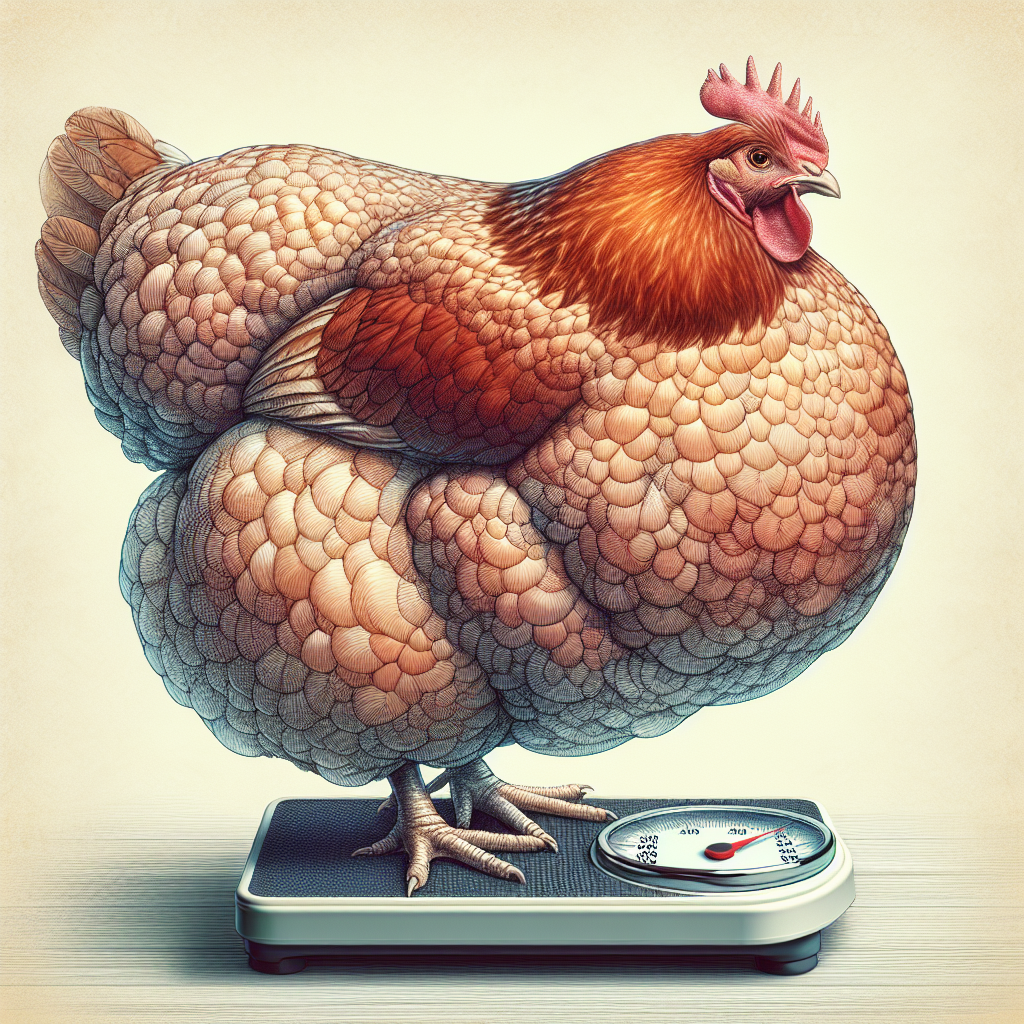Are you a poultry enthusiast or just looking for a way to provide your feathered friends with the best nutrition possible? Look no further! In this article, we will explore the art of making your own chicken feed at home. You will discover the benefits of crafting your own blend, the essential ingredients to include, and step-by-step instructions on how to create a wholesome meal that will keep your chickens clucking happily. So, grab your apron and let’s start creating a homemade chicken feed that will have your flock clucking for joy!
Understanding the Nutritional Needs of Chickens
Chickens, just like any other living beings, have specific nutritional needs that must be met in order for them to thrive and stay healthy. By understanding the basics of chicken nutrition and determining the nutritional requirements for different stages of chickens, you can ensure that your feathered friends receive a well-balanced diet. Additionally, formulating homemade chicken feed allows you to have control over the ingredients and quality of the feed, ensuring that your chickens are getting the best nutrition possible.
Knowing the Basics of Chicken Nutrition
Before diving into the specifics of homemade chicken feed, it’s important to have a basic understanding of what chickens need in terms of nutrients. Chickens require a combination of carbohydrates, proteins, fats, vitamins, minerals, and water in their diet. Carbohydrates provide them with energy, while proteins are essential for growth, development, and the production of eggs. Fats are necessary for healthy skin and feathers, as well as providing a concentrated source of energy. Vitamins and minerals play vital roles in various bodily functions, and water is essential for digestion, temperature regulation, and overall hydration.
Determining the Nutritional Requirements for Different Stages of Chickens
Chickens go through different stages of life, each with their specific growth and nutritional needs. It’s crucial to adjust their feed accordingly to support their development. The three main stages of chickens are chicks, adolescents, and laying hens. Starter feed for chicks should contain higher protein levels to promote healthy growth. The grower feed for adolescents aims at supporting their physical development. Finally, layer feed for laying hens focuses on supporting egg production. By understanding the nutritional requirements for each stage, you can tailor your homemade chicken feed recipes to meet their specific needs.
Factors to Consider When Formulating Homemade Chicken Feed
When creating homemade chicken feed, several factors need to be considered to ensure that your chickens receive a well-rounded and balanced diet. These factors include choosing the right grains, selecting protein sources, incorporating fruits and vegetables, adding essential fats, and including supplements and additives.
Choosing the Right Grains
Grains are a major component of chicken feed and provide a significant portion of their carbohydrate and energy needs. Commonly used grains include corn, wheat, barley, and oats. When selecting grains, consider their availability, cost, and nutritional profile. It’s important to use a variety of grains to provide a diverse range of nutrients to your chickens.
Selecting Protein Sources
Protein is crucial for chickens’ growth, feather development, and egg production. Protein sources can include soybean meal, fish meal, meat scraps, or even insects. Make sure to choose high-quality protein sources that meet the nutritional requirements of your chickens at each stage of their development.
Incorporating Fruits and Vegetables
Fruits and vegetables are an excellent source of vitamins, minerals, and antioxidants. Consider incorporating a variety of fruits and vegetables into your homemade chicken feed recipes. Leafy greens, carrots, and bananas are just a few examples of nutritious options that can enhance the overall nutritional value of the feed.
Adding Essential Fats
Including essential fats in chicken feed is essential for healthy skin, feathers, and overall well-being. Sources of essential fats can include flaxseed, sunflower seeds, or even small amounts of vegetable oil. Be cautious not to overdo the fat content, as excessive amounts can lead to obesity and other health issues in chickens.
Including Supplements and Additives
Supplements and additives can play a crucial role in meeting the specific needs of your chickens. They can include calcium supplements for stronger eggshells, probiotics for better digestion, or herbal remedies for overall health and immunity. Consult with a poultry nutritionist or veterinarian to determine which supplements and additives are appropriate for your chickens.
Recipes for Homemade Chicken Feed
Now that you understand the nutritional needs of chickens and the factors to consider when formulating homemade chicken feed, let’s dive into some recipes tailored to different stages of chickens.
Recipe 1: Starter Feed for Chicks
Ingredients:
- 60% grains (such as corn, wheat, and barley)
- 20% protein source (such as soybean meal)
- 10% minerals and vitamins
- 10% fats (such as flaxseed)
Instructions:
- Mix all the ingredients thoroughly in a clean container.
- Store the starter feed in an airtight container in a cool, dry place.
- Feed the chicks with this mixture from hatching until they are about 8 weeks old.
Recipe 2: Grower Feed for Adolescents
Ingredients:
- 50% grains (such as wheat, oats, and barley)
- 25% protein source (such as fish meal or insect larvae)
- 10% minerals and vitamins
- 10% fruits and vegetables (such as leafy greens, carrots, and apples)
- 5% fats (such as sunflower seeds)
Instructions:
- Thoroughly mix all the ingredients in a clean container.
- Store the grower feed in an airtight container in a cool, dry place.
- Feed the adolescent chickens with this mixture from 8 weeks until they start laying eggs.
Recipe 3: Layer Feed for Laying Hens
Ingredients:
- 50% grains (such as corn, wheat, and oats)
- 20% protein source (such as soybean meal)
- 10% calcium supplements
- 10% fruits and vegetables (such as leafy greens, carrots, and bananas)
- 5% fats (such as flaxseed)
- 5% minerals and vitamins
Instructions:
- Thoroughly mix all the ingredients in a clean container.
- Store the layer feed in an airtight container in a cool, dry place.
- Feed the laying hens with this mixture to promote healthy egg production.
Recipe 4: Broiler Feed for Meat Birds
Ingredients:
- 60% grains (such as corn and wheat)
- 25% protein source (such as soybean meal)
- 10% minerals and vitamins
- 5% fats (such as vegetable oil)
Instructions:
- Thoroughly mix all the ingredients in a clean container.
- Store the broiler feed in an airtight container in a cool, dry place.
- Feed the meat birds with this mixture to support their rapid growth.
Calculating Ratios and Quantities
Now that you have recipes for homemade chicken feed, it’s important to understand the importance of balancing nutrients and calculating ratios and quantities.
Understanding the Importance of Balancing Nutrients
Balancing nutrients in chicken feed is essential to ensure that your chickens receive the right amounts of carbohydrates, proteins, fats, vitamins, and minerals. A well-balanced diet will promote optimal growth, egg production, and overall health in your flock.
Calculating Percentages and Ratios
When formulating homemade chicken feed, you need to calculate the percentage of each ingredient based on its nutritional contribution. For example, if your recipe requires 50% grains, 20% protein source, and 10% minerals and vitamins, you can calculate the exact quantity of each ingredient based on the desired batch size.
Determining Daily Feed Intake
To determine the daily feed intake for your chickens, consider their age, breed, and production level. Generally, chickens require about 0.25 to 0.5 pounds of feed per day. However, this can vary based on individual factors. Monitor your chickens’ behavior and adjust their feed intake as needed to ensure they’re neither overeating nor hungry.
Grinding and Mixing Homemade Chicken Feed
To ensure optimal digestion and nutrient absorption, it’s important to grind and mix homemade chicken feed properly.
Selecting the Right Feed Grinding Equipment
Investing in a good quality feed grinder is crucial for producing finely ground feed. Look for a grinder that can handle the volume of feed you’re producing and produces a consistent grind size.
Properly Grinding Different Ingredients
Different ingredients may require different grind sizes. Grains, for example, should be finely ground, while larger seeds, such as sunflower seeds, can be lightly ground to allow for easier consumption. Experiment with grinding settings to find the optimal sizes for each ingredient.
Ensuring Homogeneous Mixing of Feed
After grinding all the ingredients, it’s crucial to mix them thoroughly to ensure the feed is homogeneous. Use a clean container and mix all the ingredients until they are evenly distributed. This will prevent any chicken from selectively eating certain parts of the feed, ensuring balanced nutrition for the entire flock.
Storage and Preservation of Homemade Chicken Feed
Proper storage and preservation of homemade chicken feed are essential to maintain its quality and prevent spoilage.
Choosing the Right Storage Containers
Invest in airtight containers made of food-grade materials to store your homemade chicken feed. Avoid using containers that are prone to absorbing moisture or leaching chemicals into the feed. Consider using large buckets or metal bins with tight-fitting lids.
Protecting Feed from Moisture and Pest Infestation
Moisture can compromise the quality of the feed, leading to mold or spoilage. Store the feed in a cool, dry place away from direct sunlight. Additionally, take measures to prevent pests, such as rats or insects, from accessing the feed. Regularly check for signs of infestation and take necessary steps to eliminate any pests.
Expiration Dates and Feed Rotation
Homemade chicken feed, just like commercial feed, has a shelf life. Although it doesn’t usually come with an expiration date, it’s recommended to use the feed within three months to ensure optimal freshness and nutritional value. Implement a first-in, first-out rotation system to prevent feed from sitting for extended periods. This way, you can ensure that your chickens always have access to fresh and nutritious feed.
Feeding Guidelines and Observing Chicken Health
Feeding your chickens the right amount of feed and monitoring their behavior and health is crucial for their overall well-being.
Monitoring Feed Consumption and Adjusting as Needed
Regularly monitor your chickens’ feed consumption to ensure they are eating enough but not overeating. Obesity can lead to health issues, decreased egg production, or even premature death. Adjust the feed quantity accordingly to maintain a healthy weight for your birds.
Ensuring Adequate Water Availability
Water is essential for chickens’ digestion, heat regulation, and overall hydration. Ensure that your chickens have access to clean and fresh water at all times, especially during hot weather. Regularly clean and refill their water containers to prevent contamination.
Observing Chicken Behavior and Health Indicators
Observe your chickens’ behavior and general health regularly. Healthy chickens are active, have bright and alert eyes, clean feathers, and glossy combs. Any changes in behavior, such as reduced feed consumption or decreased activity, should be investigated further. Monitor for signs of nutritional deficiencies or health issues and consult with a poultry nutritionist or veterinarian if needed.
Considerations and Precautions for Homemade Chicken Feed
While homemade chicken feed has its benefits, it’s important to consider a few precautions and consult with professionals when necessary.
Consulting with a Poultry Nutritionist or Veterinarian
If you’re new to formulating homemade chicken feed or have specific concerns about your flock’s nutritional needs, it’s advisable to consult with a poultry nutritionist or veterinarian. They can provide guidance and ensure that your homemade feed recipes meet your chickens’ specific requirements.
Avoiding Toxic Ingredients and Allergens
Some ingredients, such as avocado, chocolate, or onion, can be toxic to chickens. Make sure to research and avoid using any potentially harmful ingredients in your homemade chicken feed. Additionally, be cautious if any of your chickens have known allergies or sensitivities to certain ingredients.
Understanding the Risks and Limitations
While homemade chicken feed can be a cost-effective and quality option, it’s important to understand the risks and limitations. Without proper knowledge and formulation, homemade feed may lack certain essential nutrients or minerals, leading to imbalances or deficiencies. Be diligent in your research and consult with professionals to ensure your chickens’ nutritional needs are met.
Cost Analysis and Comparative Benefits
Calculating the cost of homemade chicken feed and comparing it to commercial options is essential to understand the financial aspects and potential benefits.
Calculating the Cost of Homemade Chicken Feed
To calculate the cost of homemade chicken feed, consider the prices of all the ingredients in your recipes, including grains, protein sources, fruits and vegetables, fats, and supplements. You can then compare this cost to commercial chicken feed products to determine the cost-effectiveness of homemade options.
Comparing Homemade Feed to Commercial Options
Homemade chicken feed provides you with control over the quality of ingredients and allows you to tailor the feed to your chickens’ specific needs. Commercial feed, on the other hand, may offer convenience and variety but may contain lower-quality ingredients or unnecessary additives. Compare the pros and cons of each option to decide which one suits your situation best.
Sustainability and Environmental Benefits
Choosing to make your own chicken feed can have sustainability and environmental benefits. By sourcing local and organic ingredients, using food scraps, or growing your own feed components, you can reduce waste, carbon footprint, and dependence on commercial feed production. Consider the long-term environmental impact when deciding on homemade or commercial feed options.
Troubleshooting Common Issues with Homemade Chicken Feed
As with any endeavor, issues may arise when formulating and using homemade chicken feed. Addressing these issues promptly can prevent health problems in your flock.
Addressing Feed Aversion or Refusal
Chickens may sometimes develop aversions to certain ingredients or textures in the feed. If you notice your chickens refusing to eat the feed, evaluate the ingredients and their proportions. Experiment with different ingredients or try different grinding sizes to make it more appealing to your chickens.
Dealing with Nutrient Deficiencies or Excesses
Unbalanced feed or improperly formulated homemade recipes can result in nutrient deficiencies or excesses. Monitor your chickens’ health and observe for signs of deficiencies, such as poor feather quality, slow growth, or decreased egg production. If you suspect any imbalances, consult with a poultry nutritionist or veterinarian to address the issue.
Preventing Formation of Mold or Spoilage
Improper storage conditions or excess moisture can lead to the formation of mold or spoilage in homemade chicken feed. Regularly inspect your stored feed for any signs of mold, moisture, or foul odor. If you notice any signs of spoilage, discard the contaminated feed immediately and thoroughly clean the storage containers.
In conclusion, making your own chicken feed at home allows you to provide your feathered friends with a well-balanced and nutritious diet. By understanding the nutritional needs of chickens, formulating homemade recipes, properly grinding and mixing the feed, and ensuring proper storage and preservation, you can ensure that your chickens stay healthy and thrive. Remember to monitor their feed consumption, observe their behavior and health indicators, and consult with professionals when necessary. Homemade chicken feed offers cost savings, control over ingredients, and potential sustainability benefits. With proper knowledge and precautions, you can confidently provide your chickens with high-quality nutrition that supports their growth, egg production, and overall well-being.




